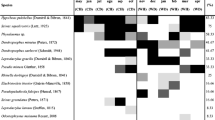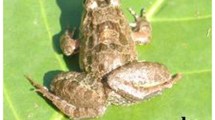Summary
At Panguana, a study in the upper Amazon basin, 7 different aquatic breeding sites of anurans were investigated from Nov. 1, 1981 to Oct. 31, 1982. Rainfall in this area is seasonal. Only 20% of the total annual precipitation was maesured during the dry period, which lasted from mid-March until mid-September 1982. The reproductive periods of the species were highly affected by the rainfall distribution. Calling males and/or gravid females of 46 species were found during the study period. 37.0% of the anuran species were exclusively, and 43.5% predominantly, active during the rainy season. Plots of 100 m2 were established at 6 aquatic sites in primary rainforest. A total of 2126 frogs was counted; 93.2% of these were made during the rainy season. A maximum of 378 individuals were found during one check in the plot at the permanent pond. At this site high concentrations of individuals and large choruses were found at the beginning of the rainy season. As soon as favourable temporary aquatic sites were established, reproductive activities decreased at the permanent pond and increased at temporary breeding sites.
Similar content being viewed by others
References
Crump ML (1974) Reproductive strategies in a tropical anuran community. Misc Publ Mus Nat Hist Univ Kansas 61:1–68
Dobkin DS, Gettinger RD (1985), Thermal aspects of anuran foam nests. J Herpetology 19 (2):271–275
Duellman WE (1978) The biology of an equatorial herpetofaua in Amazonian Ecuador. Misc Publ Mus Nat Hist Univ Kansas 65:1–352
Duellman WE, Trueb L (1986) Biology of amphibians. McGraw-Hill Book Company. (New York, St. Luis, San Francisco): 1–670
Heusser H (1969) Ethologische Bedingungen für das Vorkommen von Territorialität bei Anuren. Salamandra 5:95–104
Heyer WR (1973) Ecological interactions of frog larvae at a seasonal tropical location in Thailand. J Herpetology 7 (4):337–361
Heyer WR, Belin MS (1973) Ecological notes on five sympatric Leptodactylus (Amphibia, Leptodactylidae) from Ecuador. Herpetologica 29 (1):66–72
Heyer WR, McDiarmid RW, Weigmann DL (1975) Tadpoles, predation and habits in the tropics. Biotropica 7 (2):100–111
Lamotte M, Lescure J (1977) Tendances adaptives a l'affranchissment du milieu aquatique chez les amphibien anoures. Terre Vie 31 (2): 225–312
Macan TT (1966) The influence of predation on the fauna of a moorland fishpond. Arch Hydrobiol 61 (4):432–452
Ryan MJ, Tuttle MD, Taft LK (1981) The costs and benefits of the frog chorusing behavior. Behav. Ecol Sociobiol 8:273–278
Salthe SN, Duellman WE (1973) Quantitative constraints associated with reproductive mode in anurans. In: The evolutionary biology of anurans Vial JL (ed) Columbia Univ Missouri Press: 229–249
Schlüter A (1984) Ökologische Untersuchungen an einem Stillgewässer im tropischen Regenwald von Peru unter besonderer Berücksichtigung der Amphibien. Diss Univ Hamburg:1–300
Seigel RA (1983) Natural survival of eggs and tadpoles of the wood frog, Rana sylvatica. Copeia 1983 (4):1096–1098
Toft CA, Duellman WE (1979) Anurans of the lower Río Llullapichis, Amazonian Perú: A preliminary analysis of community structure. Herpetologica 35 (1):71–77
Wells KD (1977) The social behaviour of anuran amphibians. Anim Behav 25:666–693
Wilbur HM (1972) Competition, predation, and the structure of the Ambystoma — Rana sylvatica community. Ecology 53 (1):3–21
Woodward BD (1982) Tadpole competition in a desert anuran community. Oecologia (Berlin) 54:96–100
Author information
Authors and Affiliations
Rights and permissions
About this article
Cite this article
Aichinger, M. Annual activity patterns of anurans in a seasonal neotropical environment. Oecologia 71, 583–592 (1987). https://doi.org/10.1007/BF00379302
Received:
Issue Date:
DOI: https://doi.org/10.1007/BF00379302




